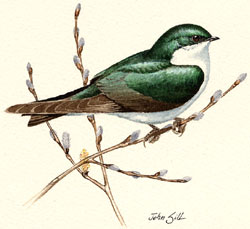Breeding Bird Atlases (BBA)
Find a Bird - BBA1
Breeding Bird Atlas 1 Species Accounts
Tree Swallow
Tachycineta bicolor
Egg Dates
April 19 to June 25
Number of Broods
one; may re-lay if first attempt fails.

The Tree Swallow is one of the more widely distributed nesting birds in Massachusetts. It is the most abundant species of swallow in the state, and during fall migration huge flocks gather along the coast, far outnumbering any other passerine migrant.
Spring migrants arrive in mid- to late March in the more sheltered swamps and river valleys, and during April they gradually spread out and reach the western and northern highlands by the end of the month. During cool, rainy periods in spring, the birds will be found almost exclusively flying low over ponds and lakes, hunting for insects close to the surface of the water. When the weather turns balmy, the birds move out over the countryside to flooded meadows, marshlands, swamps, farms, and open areas. Occasionally, spring snowstorms will bring considerable mortality to the earlier arrivals.
For nesting sites, the birds prefer wooded habitat near water, especially where dead trees are abundant, as in flooded swamps. Originally, they nested in natural cavities and old woodpecker holes in dead trees near ponds, streams, rivers, etc., but with the advent of civilization the birds readily adapted to nesting boxes erected for them on poles and trees. Tree Swallows are not colonial to any extent, although they will form loose groups when many dead trees or nesting boxes are located close together in favorable habitats such as swamps or salt marshes. The birds may be quite pugnacious in their claiming and defense of a nest site, battling individuals of both their own or other species. The song is a series of liquid twittering sounds uttered repeatedly on the wing or from a perch, and the common call note is a rapid silip, which becomes louder and harsher when the birds are agitated.
Nest height can vary from 3 feet to 60 feet or more and in Massachusetts ranged from 3 to 12 feet for 31 nest boxes. One nest was in a deciduous tree cavity at 9 feet (CNR). The actual nest is constructed from dry grasses and is lined with white feathers. The birds will go considerable distances to obtain the feathers and will sometimes play with them in the air, dropping them and then catching them in flight. Nest building activity reaches its peak during the last week of April and early May in Massachusetts, with egg laying soon afterward. Normally, four to six eggs are laid, but there have been instances when as many as ten eggs have been found when 2 females have laid in the same nest. Clutch sizes for 18 Massachusetts nests were as follows: one egg (1 nest), three eggs (2 nests), four eggs (4 nests), five eggs (6 nests), six eggs (4 nests), and seven eggs (1 nest) (CNR). Both sexes engage in nest building and feeding the young, but the female alone incubates for 13 to 16 days. The young remain in the nest 16 to 24 days, depending on brood size and food supply. Brood sizes for 21 state nests were: one young (1 nest), two young (1 nest), three young (6 nests), four young (6 nests), five young (6 nests), six young (1 nest) (CNR). Nestlings have been reported in Massachusetts from June 5 to July 23 (CNR).
One brood is raised, but the birds generally renest if the first attempt is unsuccessful. Some pairs, perhaps young birds, begin nesting activities later in the season. Loss of eggs and nestlings can be high, especially during a cold, wet spring. In one sample of 32 Massachusetts nests, at least 13 were known to have failed (CNR). Most young fledge in the Commonwealth from late June to mid-July, but there are many earlier and later records (CNR, EHF). Fledglings may perch on a dead branch or wire to be fed or may receive food from their parents in flight. The young are distinguished from adults by their brownish juvenal plumage, a brownish wash across the lower breast, and stubbier wings and tail. They molt during the fall, and the first winter plumage is very similar to the adult winter plumage.
During July and August, Tree Swallows start flocking along the coast and may be seen by the hundreds lined up on telephone wires near salt marsh and shoreline areas. The size of these flocks varies considerably from year to year, but the numbers at some locations have been estimated in the tens and hundreds of thousands in seasons of high abundance. Migration is diurnal and concentrated along the coastline in late August and September. During October, the numbers shrink rapidly, and by the end of the month most of the birds have departed except for a few stragglers on the Cape and Islands. During spells of Indian summer in November and early December, reverse migration may bring a few birds back to coastal points. During extremely warm winters, small flocks of these birds may actually survive into January and February by feeding largely on bayberries and whatever insect life they can find along beaches and salt marshes. The regular winter range extends from the southern United States south to Central America.
Map Legend and Data Summary
Atlas 1 data collected from 1975-1979


Note: locally common throughout state, especially near water
David L. Emerson



